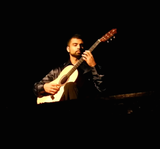La Catedral – the story behind the music
Especially because I like knowing what I’m playing, but also because I’m a fan of history in general, I wish I knew more about early 20th Century Latin America – and in particular, that I knew more about the first half of Augustin Barrios Mangore’s life. It would be nice to know if the story of La Catedral is just a poignant tale, made all the more powerful by the music of it that remains with us, or if indeed this piece is the most exquisite artistic reaction to a very real, very sad, and very definitive moment in Barrios’ life. One day I’ll dig deep enough to figure that one out, but for now, here’s how the story goes:
In 1921, Andres Segovia was 28 years old, and if the pictures are anything to go by, for the time he was a rockstar, and he knew it. He was, after all, the pre-eminent guitarist on the planet, at least by his ratings, and to give the maestro his due, by virtue of the fact that he had brought the classical guitar to maturity as a classical concert instrument, and taken it with him all over the world. While touring in Argentina, he met Barrios in Buenos Aires. Barrios was a little older, and had seen a lot more of life in the 8 years he had on the Spaniard. Both were reputed performers; Barrios was also an acclaimed poet and composer, whereas Segovia was most noteworthy for his work in expanding classical guitar repertoire through arrangement and transcription. And yet, perhaps as a proof of the fact that even in those days marketing and publicity would get you places, it was Barrios who was presented to Segovia, and called upon the latter in his hotel. One can only imagine the sparks that flew when Barrios played many of his fiery compositions for the comparatively staid, very European Segovia – on Segovia’s own guitar, at that! Barrios played the young Spaniard a lot of his music, and Segovia has noted in his diary that he thought La Catedral was a superlative piece of music…
That’s the first record we have of the piece, which, at the time, Barrios presented as just the Andante Religioso and the Allegro Solemne – he tacked the Preludio Saudade on the front later on, though it’s hard to imagine he wrote it for anything other than the theme upon which the other two pieces were supposedly written. For my part, I believe he always thought of it as three movements, but perhaps didn’t want to share the intensely personal first movement as a part of the piece at the time. Saudade is, after all, an overwhelming sort of grief, disorienting in its intensity and utterly excoriating in its effect on the human heart; it’s a pity that the teutonic and Greco-Roman sensibilities that have informed the rise and fall of words in the English language haven’t found the scope to conceive of a direct translation for it.
Anyway, the story as I know it – Barrios lost his wife, sometime in early adulthood. The experience was devastating for him. From a heart torn open by grief, he let flow an overwhelmingly personal statement of bereavement, and sorrow – an expression of his own saudade. Later, the conventions and compulsions of bereavement assumed their own momentum, and his wife’s funeral brought Barrios to a cathedral in Montevideo, Uruguay. It was here, inspired by the place, the setting, and the event, that he conceived of the rest of it, giving his wife a dirge to rival anything Chopin wrote, and a final brilliant tribute in the form of the haunting Allegro.





